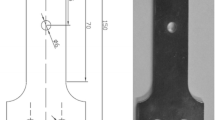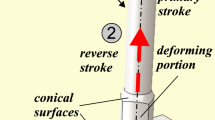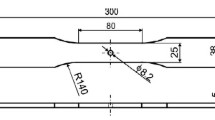Abstract
Cold expansion of fastener holes is a common way of improving fatigue performance of airframes. Among the several techniques applicable, the split-sleeve method is the most accepted in creating beneficial compressive residual stresses around expanded holes. In the present work, residual stresses at expanded holes in several types of aluminium plates produced by two different techniques, split-sleeve and roller burnishing, have been evaluated by the novel destructive Sachs method and then compared. It was found that stress distribution particularly at the vicinity of the hole was sensitive to the method of expansion and plate thickness, due to differing characteristics of the plastic material flow. Thus, secondary reverse yielding after cold expansion found to reduce residual hoop stresses at the edge of the hole, and excessive expansion above a limit, was thought to increase reverse yielding. S–N data revealed that no benefit was gained from expanding beyond this limit. It was suggested that the reduction in the number of cycles to crack initiation or more often to crack growth was due to increased reverse yielding at the vicinity of the expanded hole.
Similar content being viewed by others
References
J. L. Mann and G. S. Jost, Metal Forum 6 (1983) 43.
L. Schwarmann, Int. J. Fatigue 2 (1982) 105.
R. L. Champoux, "Fatigue Prevention and Design," edited by J. T. Barnby (Camelot Press, London, 1986) 35.
H. Lowak, "Zum Einfluss von Bauteilgr¨osse, Lastfolge und Last Horizon auf die Schwingfestigskeit-Steigerung durch Mechanisch Erzeugte Eigenspannungen" (Bericht Nr. FB-157, 1981) in German.
M. W. Ozelton and T. G. Coyle, ASTM STP 927 (1986) 53.
R. A. Pell, P. W. Weaver, J. Y. Mann and J. G. Sparrow, Fatigue Fract. Engng. Mater. Struct. 12 (1989) 53.
N. Chandawanich and W. N. Jr. Sharpe, Engng Fract. Mech. 11 (1979) 609.
A. T. Özdemİr and L. Edwards, Fatigue Fract. Engng Mater. Struct. 20 (1997) 1443.
R. Hill, "The Mathematical Theory of Plasticity" (Oxford University Press, Oxford, 1950) 100.
A. Nadai, "The Theory of Flow and Fracture in Solids" (McGraw-Hill, New York, 1950) 458.
Y. C. Hsu and R. G. Foreman, J. App. Mech. Trans. ASME 42 (1975) 347.
W. Ramsberg and W. R. Osgood, "National Advisory Committee for Aeronautics,"NACATN 902(Washington DC, 1943).
D. L. Rich and L. F. Impellizzeri, ASTM STP 637 (1977) 153.
G. S. Wang, Int. J. Press. Vess. Piping 33 (1988) 269.
P. C. T. Chen, "A New Method of Predicting Residual Stress in Autofrettaged Gun Barrels," Technical Report ARCCBTr-86012 (US Army Armament Research and Development Center, Watervliet, 1986).
Zhu Wu-xue and Zha Zi-Chu, Acta Mechanica Sinica 19 (1987) 245.
M. M. Megahed and A. T. Abbas, Int. J. Mech. Sci. 33 (1991) 139.
G. C. Poussard, M. J. Pavier and D. J. Smith, J. Strain Anal. 30 (1995) 291.
D. L. Ball, Fatigue Fract. Engng Mater. Struct. 18 (1995) 47.
R. P. Carey, "Computed Stress and Strain Distributions under Interference Fit and After Cold Working," AR-904–548 (Aeronautical Research Laboratories, Melbourne, Victoria, 1987).
G. Dietrich and J. M. Potter, Adv. X-ray Anal. 20 (1977) 321.
A. T. Özdemİr, Phd thesis, The Open University, Milton Keynes (1993).
A. T. Özdemİr, R. Cook and L. Edwards, in Durability and Structural Integrity of Airframes, Proceedings ICAF '93.
Rights and permissions
About this article
Cite this article
Özdemir, A.T., Hermann, R. Effect of expansion technique and plate thickness on near-hole residual stresses and fatigue life of cold expanded holes. Journal of Materials Science 34, 1243–1252 (1999). https://doi.org/10.1023/A:1004521309415
Issue Date:
DOI: https://doi.org/10.1023/A:1004521309415




